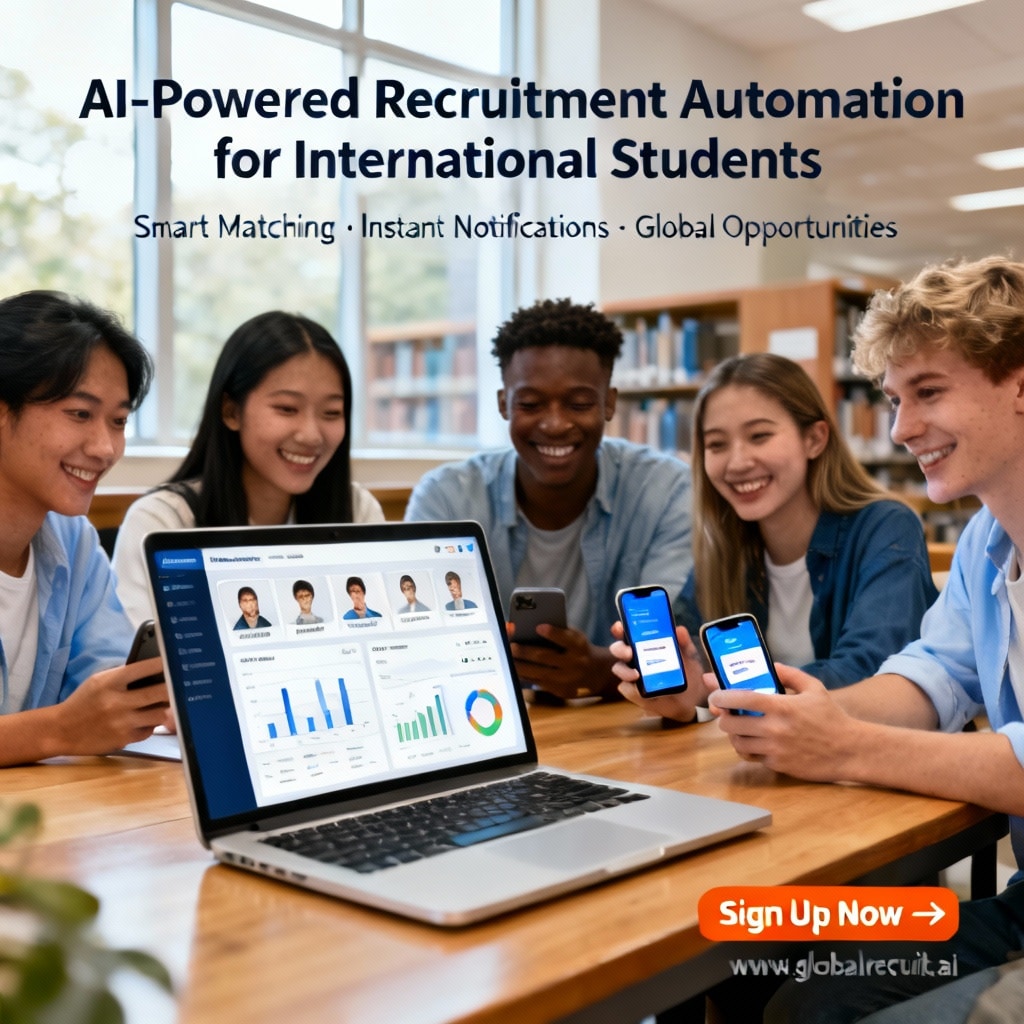AI-Powered Recruitment Automation for International Student Recruitment
Why this matters now
- Global competition for international students is intensifying. Institutions that respond quickly and personally to inquiries convert a far higher share of prospects.
- Prospective international students expect 24/7 responsiveness, multilingual support, and tailored program recommendations — demands that manual processes cannot meet at scale.
- AI-powered automation reduces repetitive tasks, increases counselor productivity, and provides data-driven insights to optimize budgets and channels.
Core benefits for university admissions and agents
- Faster lead response times (automated triage and chatbot engagement).
- Higher lead-to-application conversion through personalized nurture sequences.
- Better resource allocation — admissions counselors focus on high-value, high-propensity students.
- Scalable multilingual outreach without needing large regional teams.
- Real-time analytics for campaign optimization and budget allocation.
Implementation roadmap — from strategy to operation
Phase 1 — Strategy and audit (1–2 weeks)
- Map your current recruitment funnel: inquiry → pre-qualification → application → admission → enrollment.
- Identify bottlenecks and manual handoffs where automation can reduce latency.
- Define target student profiles by geography, language, discipline, and funding status.
Phase 2 — Choose platform and architecture (2–3 weeks)
- Select a CRM with open APIs and a marketing automation engine capable of event-based triggers.
- Choose AI features relevant to your needs: multilingual NLU (natural language understanding), lead-scoring models, and content personalization.
Phase 3 — Build conversational flows, lead scoring, and content (3–6 weeks)
- Design conversation trees for common queries: eligibility, program duration, tuition, scholarships, accommodation, and visa steps.
- Train AI chatbots with FAQs and local nuances; include human handoff rules for complex queries.
Phase 4 — Integrate and test (2–4 weeks)
- Test end-to-end flows: inbound lead → automated qualification → counselor handoff → application creation.
- Conduct bilingual testing where necessary (English + target languages).
Phase 5 — Launch, monitor, iterate (ongoing)
- Start with pilot markets or programs and iterate based on KPI performance.
- Continuously train AI models with new conversation logs and admission outcomes.
Use cases and university examples — practical scenarios
Medicine and health sciences
If your recruitment focus includes medicine, prioritize institutions with strong medical programs such as Istinye University and Medipol University.
Engineering, business, and design programs
For STEM, business, and creative programs, highlight universities with international partnerships and strong English-language delivery such as Ozyegin University and Bilgi University.
Regional campus and private university recruitment
Private institutions and regional campuses benefit from automation that demonstrates student life, accommodation options, and practical support. Use personalized drip campaigns that introduce prospective students to campuses such as Beykent University and Bahcesehir University.
KPIs and analytics — what to measure
Conversion and funnel metrics
- Lead response time (goal: under 10 minutes for high-intent channels).
- Lead-to-application conversion rate.
- Application completion rate.
- Offer-to-enrolment yield.
Cost and channel efficiency
- Cost per lead by channel (paid, organic, agency).
- Cost per enrolled student.
- Channel ROI by region and program.
Engagement and quality
- Average interaction depth with AI/chatbot before human handoff.
- Document submission timeliness.
- Student satisfaction with admissions communication.
Predictive performance
- Predictive lead score accuracy and lift in conversion for top-scoring leads.
- Time-to-offer improvements after automation rollout.
Operational and compliance considerations
Data privacy and security
- Ensure personal data is stored securely and cross-border data flows conform to applicable regulations.
- Implement role-based access in your CRM and limit PII exposure in automated logs.
Localization and cultural nuance
- Localize not only language but also examples, tuition expectations, and scholarship messaging.
- Train chatbots with region-specific phrases and channels.
Human + AI governance
- Define clear escalation rules: when the bot passes to a human counselor and SLA targets for counselor response.
- Monitor AI responses regularly and retrain models based on admission counselor feedback.
How Study in Turkiye partners with universities and agencies
Study in Turkiye provides a full-service model combining market insight, process automation, and local student services to maximize international recruitment outcomes.
- Strategic program mapping and recruitment channel planning tailored to your target markets.
- End-to-end automation design: CRM integration, chatbot implementation, lead scoring, and reporting.
- Localized messaging, multilingual chatflows, and culturally optimized campaigns.
- Operational support in admissions processing, document verification, visa guidance, and student services.
Take the Next Step with Study in Turkiye
If your admissions team, recruitment agency, or university HR group is ready to implement AI-Powered Recruitment Automation for International Student Recruitment, contact Study in Turkiye today. We will assess your current funnel, design a pragmatic automation roadmap, and pilot a solution aligned with your enrollment targets.

